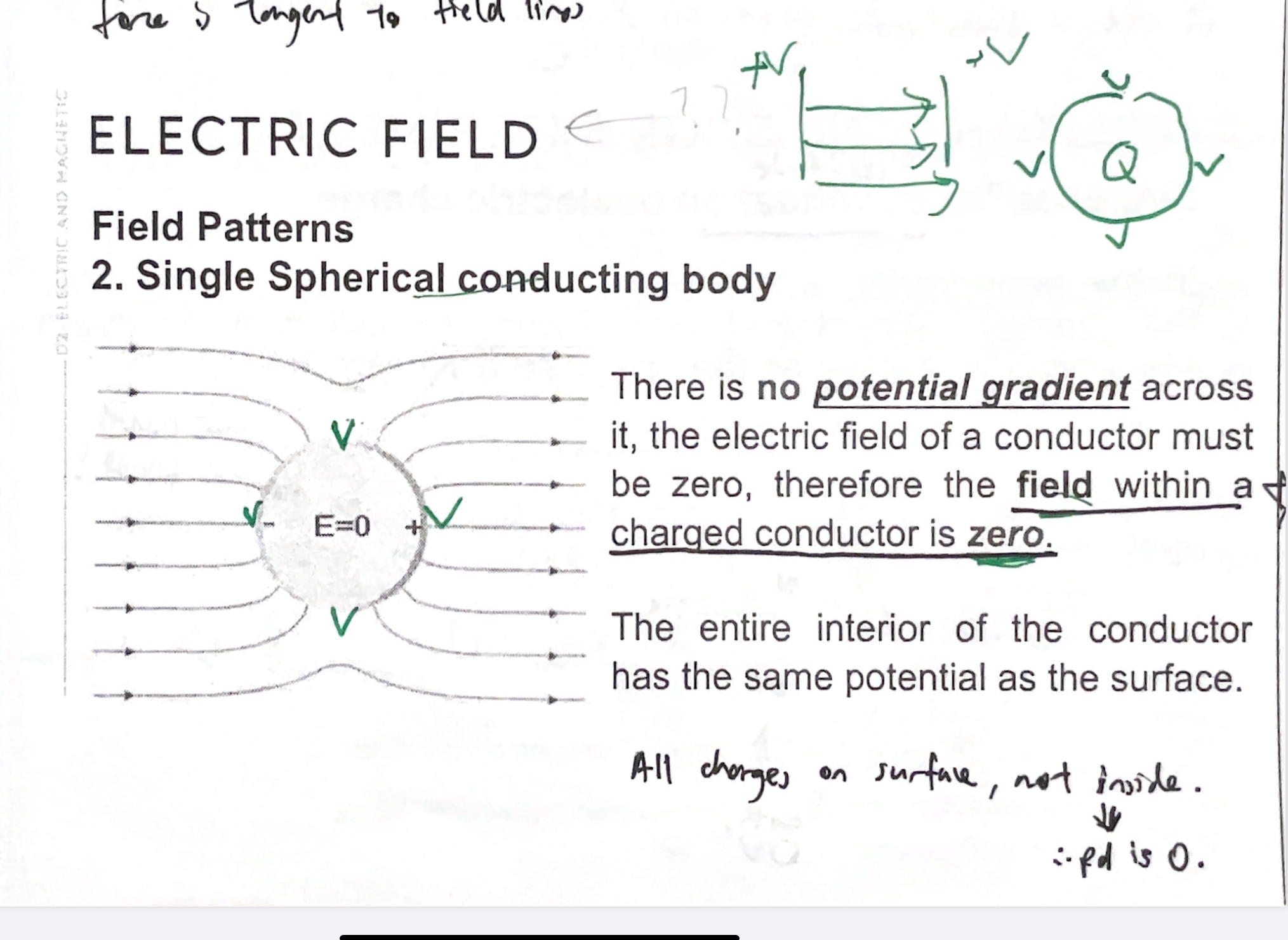phy D2 electric and magnetic fields
1/19
There's no tags or description
Looks like no tags are added yet.
Name | Mastery | Learn | Test | Matching | Spaced |
|---|
No study sessions yet.
20 Terms
conservation of electric charge
charges cannot be created nor destroyed, can be transferred from one body to another
charged particles are particles that
carry electric charges
and hence produce electric fields
proton/electron have equal amount of charge, opposite polarity
methods of transferring electric charge
friction
electromagnetic induction
contact
earthing
charging by friction
When two non-conductors are rubbed together, electrons can be transferred from one material to the other.
One material ends up with more electrons (negative charge), and the other with fewer electrons (positive charge) → charge of equal magnitude but opposite polarity
charging by electromagnetic induction
negatively charged rod brought near (but not touching) a metal conductor that is initially electrically neutral
free-moving electrons in metal undergo redistribution of charges due to induction effect
near end has more positive charge than negative
far end has more negative charge than positive
sphere is grounded, electrons transferred to earth
ground connection broken and negative rod removed, sphere will have positive charge
charging by contact (gold leaf electroscope)
The electroscope is neutral — its leaves hang straight down
charged rod put on the metal disc of the electroscope.
Since the metal is a conductor, electrons can move: some electrons from charged rod flow onto the surface of the electroscope and then to the leaves
leaves become negatively charged, repel each other, rises away from plate
the bigger the charge the more the leaf rises
charging by earthing
positively charged rod brought near neutral conductor Q on insulating stand
electrons on conductor Q attracted to positively charged rod P
earthing by touch: electrons flow from earth to neutralise positive charge at opposite side of conductor Q
after breaking contact with conductor (ie stop touching), remove positively charged rod. resulting conductor Q is negatively charged due to excess electrons.
electric charge is quantised
charge exists as discrete units of elementary charge e = 1.6 × 10-19
proof: millikan’s oil drop experiment
fine mist of oil drops sprayed into chamber
passed through nozzle and ionised by x-rays (added/removed electrons)
when E-field switched off (no potential difference across the two plates):
oil drops fall under gravity
reach terminal velocity v when drag force = gravitational force
when E-field switched on (potential difference applied across the two plates)
some oil drops become stationary (no drag force) or rise upwards with new terminal velocity v’
balance of forces enabled charge on individual oil drops to be determined
charges found to have common factor 1.6×10-19 C
note: charge is a scalar quantity even though it has +/-
electric field
region of space where stationary charge experiences a force
direction of electric field: direction in which a positive charge would move if it were free to do so
electric field patterns for single point charge

electric field patterns for single spherical conducting body
no potential gradient across conductor (since charges free to move in conductor, would redistribute)
therefore no electric field
electric field of conductor is zero therefore field within charged conductor is zero.
entire interior of conductor has same potential as the surface
all charges are on the surface, not inside the conductor → potential difference is 0

electric field patterns between 2 point charges

electric field patterns between parallel charged plates
equally spaced lines → uniform, regardless of the charged particle’s distance from either plate
magnitude E of electric field strength is uniform E = V / d (units: V m^-1, this formula only applies to parallel plates)
V is potential difference between plates (magnitude only, no sign
d is perpendicular distance between the plates
from positive to negative, since potential decreasing

coulomb’s law
the magnitude of the force between two point charges is directly proportional to the product of the magnitude of the charges and inversely proportional to the square of their separation
F=k Qq/r²
assumptions
point charges
separation of the two spheres is large compared to radii, so take as if charges concentrated at centres
equal and opposite force acting on each mass (even if masses are not equal)
electric field strength
(at a point in the electric field) is the electric force exerted per unit charge on a small stationary positive charge placed at that point
E = F/q = kQ/r² (units V m^-1)
where F is the electric force
q is the charge of the point charge
where Q is the source charge creating the field
notes
small: point charges separation
stationary: if moving in a magnetic field, would have electromagnetic force FB)
positive charge: same direction as electric field
magnetic field
region of space where a small magnet would experience a turning force
direction is the direction in which a north-seeking pole points
magnetic field pattern of straight current carrying conductor
concentric circular magnetic field lines around the straight conductor, with increasing distance between field lines
direction follows RHGR
magnetic field pattern of single turn coil

magnetic field pattern of solenoid

electron vs proton released from rest in electric field caused by a point negative charge (common test q2a iii)
force on both is same initially
proton mass is more so initial acceleration is less than electron
but proton acceleration increases as it moves into stronger field (field lines are closer to each other) and vice versa for electron